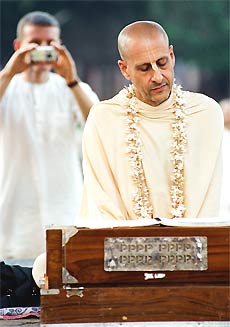When one offers me in devotion a leaf, a flower, a fruit or water, I accept that loving offering, as it is rendered out of a pure heart. (Bhagavad Gita 9.26)
Flowers are a beautiful creation of God. Why not offer them back to the creator with love and gratitude? The annual flower festival at the Radha Gopinath Temple in Mumbai, India, embodies this idea through an exciting event that has been touching the very souls of the participants since the inception. The festival begins in the morning with hundreds of volunteers plucking flower petals from over a ton of wide variety of flowers brought from all over India. During the seva, Radhanath Swami inspires all the participants with a talk on the principles of bhakti and the spirit of this festival.
“It is not the thing that counts, but the purpose with which we offer,” says Radhanath Swami. When a child offers a cookie – prepared by his mother – back to his mother, there is an exchange of affection. Similarly, God does not want our things-in-themselves. Bhagavad Gita explains, “If one offers with love even a flower, fruit, leaf or water, God accepts it because he is hungry for our love – though he is self-satisfied.” God is full in himself, but still yearns to love. The Vedic literatures are filled with such stories of God’s reciprocation. In the Srimad Bhagavatam comes the narration of Sudama, a childhood friend of the Supreme Lord Krishna. Sudama, being very poor, went to meet Krishna, who was then the king of the Dwaraka city, with a small pouch of cheap chipped rice as a gift. But Krishna was so pleased with his offering of love that he reciprocated with deep friendship and presented Sudama with great riches. Similarly, in the Ramayana comes the tale of the Supreme Lord Rama constructing the bridge across the ocean with the help of his soldiers. The Lord instructed the mighty warrior Hanuman, “Your herculean effort in building the bridge with huge boulders and the apparently tiny effort of a spider (also assisting in building the bridge) are the same in my eyes.”
The festival also exemplifies the spirit of unity in diversity. Bhakti unites everyone with the common purpose of serving and pleasing God. People from distant countries with a variety of socio-economic backgrounds – rich industrialists, simple monks, farmers, housewives, intellectuals, old and young people, parents, children – everyone sit on the same floor to do the simple act of plucking flower petals. “We all feel that we have plucked these flowers as one big family,” says Radhanath Swami. “Diversity is really beautiful if we understand the unity. Instead of fighting over the differences, we become one in purpose to make this offering of our love to God.”
In the evening, the forms of Radha and Krishna (Radha Gopinath) are bathed with fragrant colourful petals – orange marigolds, pink and red roses, white jasmine and so on. The event reaches the crescendo with the showering of these same petals onto the participants of the festival. Amidst chanting and dancing in the rousing kirtan, everyone throws flower petals on each other with great joy and happiness. “Showered by flower petals in Mumbai – experience I will never forget,” tweeted Valentina Zelyaeva, one of the top 10 models in the world, who attended the festival in 2015.






















Wonderful and inspiring talk by HH Radhanath Swami. The wisdom shared here so to practical and makes perfect sense. The principle of engaging everything in the service of the Lord is the ultimate understanding of Bhakti and this festival seems to be doing this so well.
The Flower festival or Pushyabhishek is a wonderful treat to the senses and the soul. It’s so purifying to sit together to pluck the petals to be offered to the Lord. As rightly said by Radhanath Swami ” The festival also exemplifies the spirit of unity in diversity”.